Just a week over the drop of the full length ‘teaser’ trailer from Prime Video, today fans were treated to a FULL trailer (3min long) for The Lord of the Rings: The Rings of Power. Timed for release in the midst of San Diego Comic-con – and dropping during Prime Video’s Hall H panel – this trailer certainly sweeps away the coy hinting, and gives us a real look at what the story of Rings of Power may be; at least in the first season. But it may also pose more questions than it answers. Take a look:
Category: The Rings of Power
Check out an exclusive and entertaining interview with our favorite Merry and Pippin, Dominic Monaghan and Billy Boyd from /Film. In the wide ranging interview, they discuss their recent Hobbit reunion (and plans for more), San Diego Comic-Con memories, and advice for The Rings of Power cast.
These comic conventions that in 20 years since we’ve made the movies, we’ve never done one together, all four of us, and met the fans and said hello and stuff. Someone came to us and had that idea to do a sort of Hobbit get-together and do a show. It’s been really fun so we’re doing six of them this year, different cities — Toronto, Boston, Dallas — and it’s been great.
– Billy on their recent viral reunion
I think with “The Lord of the Rings” trilogy and everything surrounding it, in a lot of ways that fandom has become the most fervent, the most passionate. They’re the biggest fandom and no one can compute something being bigger, but over the course of time, something will come along that will be bigger, but it won’t diminish what happened with that Peter Jackson trilogy, because it’s an extraordinary piece of work.
– Dominic on the LOTR fandom
My only advice that I would give to any cast members making “The Lord of the Rings” Amazon show now is, if you’re having great days on set and you’ve made great friends and you love the crew and you love the job that you did, don’t worry about the rest of it. You are working on an amazing job in that case, because if you can go to work and enjoy yourself, everyone else’s opinion doesn’t really matter.
– Dominic on his advice to the cast of The Rings of Power
Per a new popculture interview, Billy and Dom plan to watch and talk about the first episode of Rings of Power for their The Friendship Onion podcast in the future. Stay tuned.
Check out our detailed write-up on everything you need to know about the panels, booths and events for Middle-earth fans going to San Diego Comic-Con 2022.
Exciting confirmation from Deadline that both Howard Shore and Bear McCreary, long rumored and speculated about, are scoring The Rings of Power:
Howard Shore, 3-time Oscar winner for his work on The Lord of the Rings film trilogy, has returned to compose the original main title theme for its blockbuster $465 million series The Lord of the Rings: The Rings of Power. At the same time, Emmy-winner Bear McCreary has composed the full episodic series score.
…
Said McCreary: “As I set out to compose the score for this series, I strove to honor Howard Shore’s musical legacy. When I heard his majestic main title, I was struck by how perfectly his theme and my original score, though crafted separately, fit together so beautifully. I am excited for audiences to join us on this new musical journey to Middle-earth.”
Two new character themes composed by McCreary for Galadriel and Sauron are now available to stream on Amazon Music.
In an exclusive report by Devan Coggan, Entertainment Weekly confirms the grandson of J.R.R. Tolkien, Christopher’s oldest child Simon, as a consultant on AP’s Rings of Power series.
In his very own words to EW: “I have enjoyed assisting Amazon Studios in connection with the series, and in particular providing input to JD Payne and Patrick McKay on matters including my grandfather’s original writing.”
Showrunner Patrick McKay had this to say about Tolkien’s influence on their work: “His insights, attention to detail and passion for both the characters and the overall architecture of The Rings of Power are woven throughout the pages of our story.”
Check it out here, and click here for the Comic Con edition.
Editorial comment: Insert <mindblown> emoji!!
Entertainment Weekly is handing out a Comic-Con 2022 print edition exclusively at SDCC with The Rings of Power on its cover. Per their website, this special edition cover has a first look at Númenor, “the legendary island kingdom that’s never before been depicted on screen.”
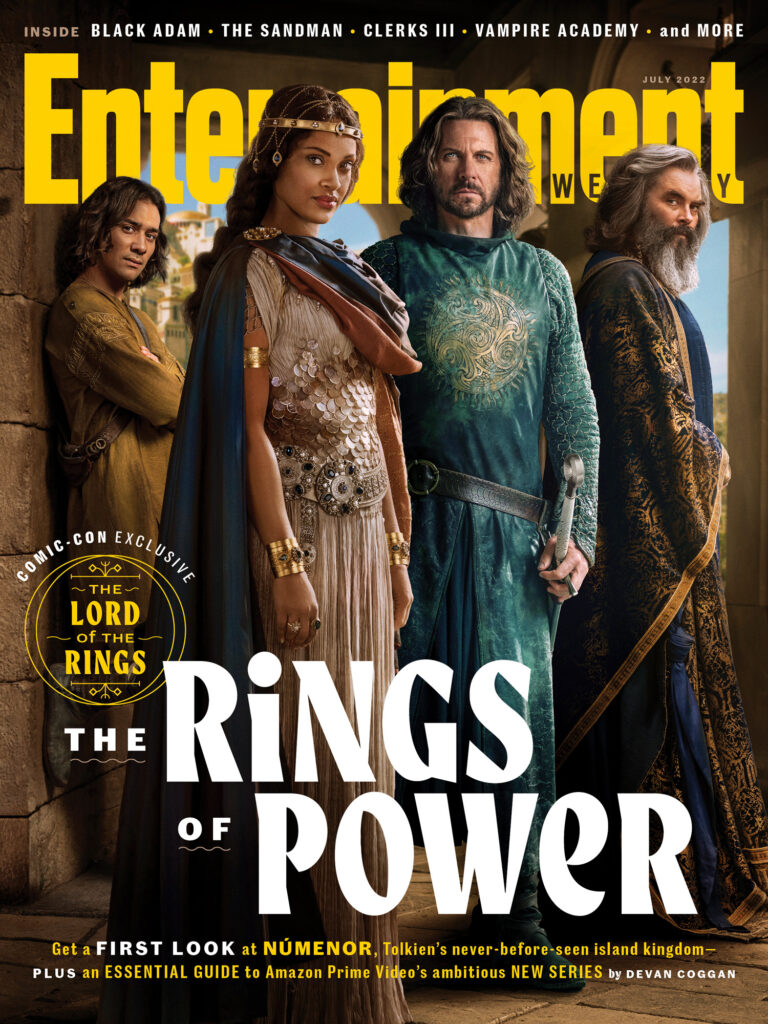
More from EW:
Númenor looms large in Tolkien’s legendarium, and EW’s cover introduces four key residents who will play a major role in The Rings of Power.
Cynthia Addai-Robinson stars as the queen regent Míriel, who descends from a long line of royal leaders. Her closest advisor is Pharazôn (far right), played by Welsh actor Trystan Gravelle. Rounding out the cover are seafarer Elendil (center right), played by Lloyd Owen, and Elendil’s son Isildur (far left), played by Maxim Baldry.
EW’s full issue includes exclusive interviews with the cast, as well as key creatives like Payne and McKay, director Wayne Che Yip, and production designer Ramsey Avery.
Additional images with character insights and an interview with production designer Ramsey Avery are also up on EW.com with more to come.
Check out our detailed write-up on everything you need to know about the panels, booths and events for Middle-earth fans going to San Diego Comic-Con 2022.
Right now, nothing about our shiny, new Rings of Power trailer is exercising my mind more than Galadriel’s statement to Elrond “You’ve not seen what I’ve seen”.
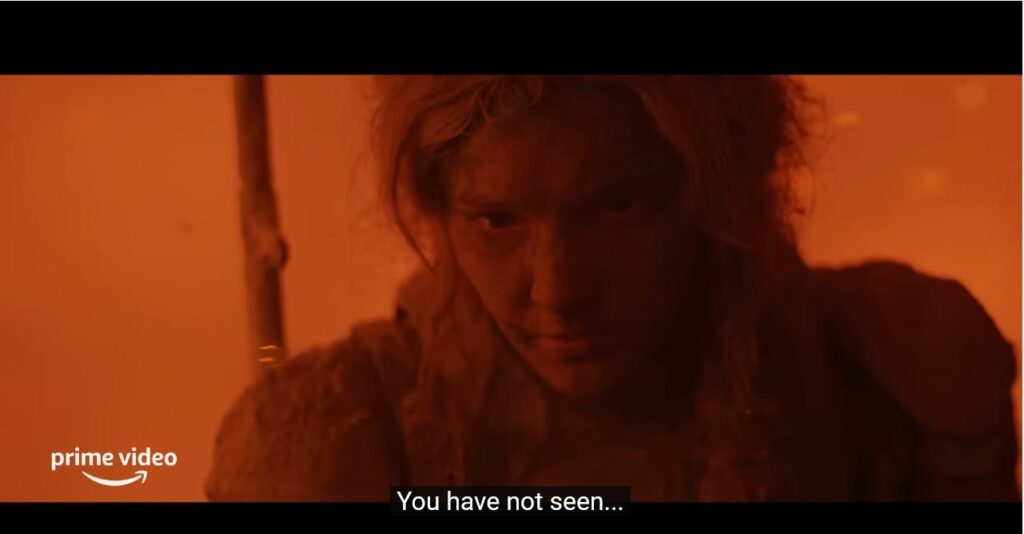
Why?
Well, even by the first year of the Second Age, Elrond had seen and endured quite a bit: extended parental absences and the wholly unwarranted slaughter of family and friends by kinfolk who subsequently adopt him (and his twin brother). Sometime later, said kin, seemingly, abandon him in favour of some shiny gems.
This is some Grave of the Fireflies-scale trauma.
So you wouldn’t think that Galadriel means something similar, like that one time at Aqualondë when Fëanor decided to requisition some boats (or, later, when he decided to use said boats for tinder on the beach at Losgar).
It’s also likely that Elrond was involved in the The War of Wrath and present at Thangorodrim for the defeat of Morgoth at the conclusion of the First Age. It’s implicit in his statement during the Council of Elrond when he speaks of the Last Alliance.
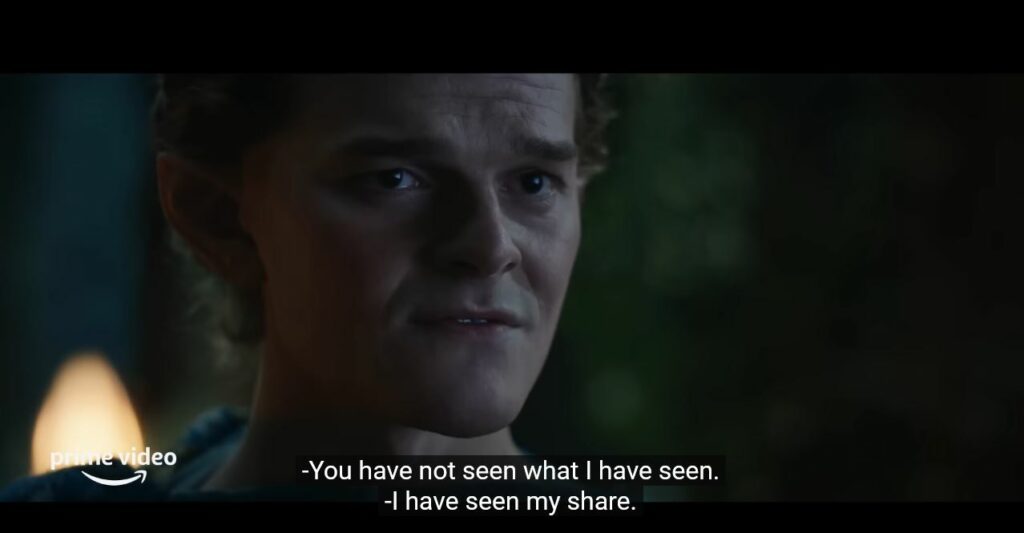
“I remember well the splendour of their banners,” he said. “It recalled to me the glory of the Elder Days and the hosts of Beleriand, so many great princes and captains were assembled. And yet not so many, nor so fair, as when Thangorodrim was broken…”
The Council of Elrond, The Lord of the Rings
Arguably that’s the defining event of the First Age (even if it’s the most-sketchily recorded). A dragon falls on and destroys a mountain chain. Later, an entire sub-continent sinks as a result. It is, quite literally, a world-changing event.
Let’s say your preferred canon is that Galadriel remained in Doriath into the later stages of the First Age (one option CJRT outlines in Unfinished Tales), the sacking of Menegroth doesn’t remotely meet that benchmark. Even were you to place Galadriel at the Nirnaeth Arnoediad (I wouldn’t), or the Dagor Bragollach (a big stretch, but I do wonder if the showrunners might), it’s just not comparable.
So what’s left?
I broached this with fellow staffers, suggesting that only one thing in Galadriel’s history is truly incomparable: the destruction of the Two Trees by Morgoth and Ungoliant.
But, generally, we agree that the description of that event given in The Silmarillion is a poor match for the imagery from the scenes that Galadriel’s voice-over cuts across in the trailer. The Silmarillion describes that Laurelin and Telperion wither as Ungoliant drains them of life. They do not burn. The assault causes a vast, ever-expanding gloom and darkness, and it is entirely unexpected and unanticipated.
That’s very unlike what we see in the Rings of Power trailer scene. There’s a the red-hued background, flickering embers pass behind Galadriel, and there are bodies that seem to hang in space. Further, whatever Galadriel is looking on seems to centre on something that looks like a tower, or a fortress. Not trees.

If it’s not something in Galadriel’s (distant) past, what is it then?
Perhaps it’s some Second Age event around or during timeline that The Rings of Power covers.
Here, fellow-staffer Garfeimao cleverly suggests that we should keep in mind that Galadriel has powers of foresight. This, after all, is how Sam is able to see a vision of The Shire getting, let us say, redeveloped.
“Many things I can command the Mirror to reveal,” she answered, “and to some I can show what they desire to see. But the Mirror will also show things unbidden, and those are often stranger and more profitable than things which we wish to behold. What you will see, if you leave the Mirror free to work, I cannot tell. For it shows things that were, and things that are, things that yet may be. But which it is that he sees, even the wisest cannot always tell. Do you wish to look?”
The Mirror of Galadriel, The Lord of the Rings
Scholar Michael Martinez suggests that — at that point — Galadriel’s reach may have been increased since she was able to use the Ring of Adamant, Nenya freely. Yet he also clearly believes that Galadriel had always possessed a native foresight of her own.

I could see some pointing out that Elrond also has a mighty foresight. And that’s true.
For example, his concern for welfare of The Shire is not at all misplaced. But he also doesn’t intuit how critical Merry and Pippin would prove to the Quest to destroy the Ring. That’s not to say his foreknowledge is less, it’s more to showcase how imprecise such things can be in Tolkien. No-one ever sees the full picture — even the memories of the Valar of the Music are said to be fuzzy.
And a vision might explain the subtle differences between the two shots: Galadriel is not physically present at the second scene. Instead she’s perceiving it through the lens of vision — just as Frodo and Sam did in Lorien — from somewhere else that is distant in both place and time. Somewhere else that — in a sneaky bit of misdirection — just happens to have endured some sort of fire or assault.
Recall, also, that such visions and dreams in Tolkien can be the cause of great restlessness in the receiver. In The Silmarillion, Turgon and Finrod each receive a vision from Ulmo while resting by the banks of the Sirion.
“Unquiet was upon them ever after, and doubt of what should befall, and they wandered often alone in untrodden lands, seeking far and wide for places of hidden strength…”
Of the Return of the Noldor, The Silmarillion
This might be a key reason why Galadriel is unable to, as Elrond suggests, put down her sword.
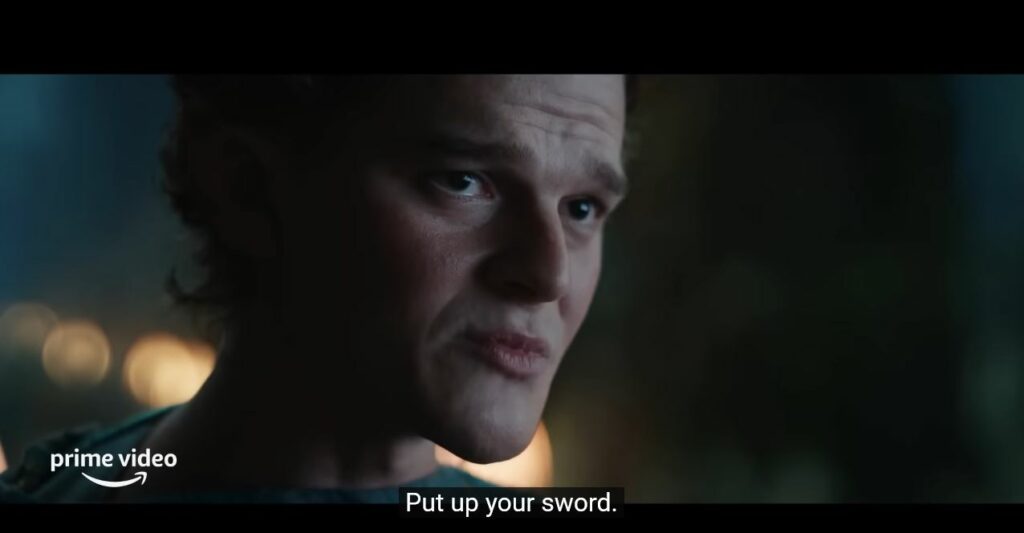
A vision opens up possibilities of things that we, as an audience, might not see come to pass in the first season of The Rings of Power.
Staffer Josh suggests that it might just be a vision of The Downfall of Númenor: Akallabêth, and perhaps even the Temple in Armenelos as it sinks below the waves.
Now, that seems appropriately apocalyptic.
It would explain why all the figures look like they’re floating — they are. And it explains the odd ripples through that scene — it’s distortions caused by the surface of the water.
The mist cleared and he saw a sight which [Frodo] had never seen before but knew at once: the Sea. Darkness fell. The sea rose and raged in a great storm. Then he saw against the Sun, sinking blood-red into a wrack of clouds [my emphasis], the black outline of a tall ship with torn sails riding up out of the West.
The Mirror of Galadriel, The Lord of the Rings
There might be powerful reasons for Amazon Studios to tip people to this end-scenario early. The fact is that most viewers won’t know what a Númenor is, let alone that it was an island-continent that was sunk after an entire people went off their collective trolley, implemented a system of human (and, presumably elven) sacrifice, and decided to invade the “land of the gods” out of a misplaced belief that conquering it would confer immortality.
Sure, even the most casual watcher will understand Ring Bad(tm), but this is vastly more tangible and visceral.
This would be one way to drive home the wider audience what’s at stake and, conceptually, I like it a lot.
Unfortunately, neither The Lord of the Rings nor its Appendices mention the “mighty temple” that Sauron has built in Armenelos, nor the sacrifices of the Faithful that are conducted inside. Those details are only found in the Akallabêth story in The Silmarillion.
However, Appendix A and Appendix B do mention that the Faithful are persecuted, and that rebellion and “civil war” occurred in the final years of Númenor.
That may be enough for the purposes of a vision. That may also satisfy a quite accurate objection that Staffer Earl raises — that the scene does have the appearance of being the outcome of battle. In fact, the most prominent floating figure seems to be run through with a spear.
Perhaps it reflects that, in those final, doomed years, “men took weapons … and slew one another for little cause; for they were become quick to anger.” Chaos and violence as the apocalypse literally occurs should not, I think, be unexpected.
But let’s say that’s incorrect and we’re not looking upon a scene of Akallabêth.
Is there something else it might be?
Here, I’m indebted to one of our Discord chatters DrNosy who informed me that the fan hivemind suspects that the trailer aerial of a city at the confluence of two rivers is Ost-in-Edhil, the chief city of Eregion.
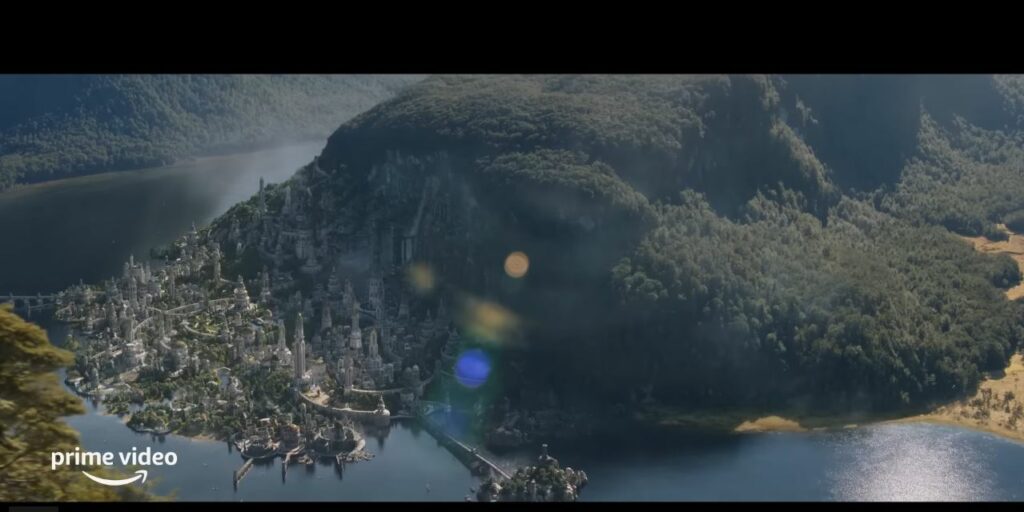
Ost-in-Edhil lies at the joining of the rivers Sirannon and Glanduin. It will be a key location for the series, since it’s where all the rings of power — lesser and greater are created (except the One). And it is beseiged, then destroyed, when Sauron leads a host into Eriador after Celebrimbor refuses to turn over the rings the elven-smiths made.
“…the Elves of this land were of a race strange to us of the silvan folk, and the trees and the grass do not now remember them: Only I hear the stones lament them: ‘Deep they delved us, high they builded us, fair they wrought us, but they are gone.'”
The Ring Goes South, The Lord of the Rings
While not as apocalyptic as the end of Númenor, it is still the end of Eregion. More, it’s the civilisational high mark of the Noldor. Although Elrond establishes subsequently a refuge in Rivendell, never again would they attempt anything on a similar scale.
A vision of the dreams of the Noldor going up in flames might just suffice.
About the author: Staffer Demosthenes has been involved with TheOneRing.net since 2001, serving first as an Associate News Editor, then as Chief News Editor during the making of the Hobbit films. Now he focuses on features and analysis. The opinions in this article are his own and do not necessarily represent those of TheOneRing.net and other staff.


